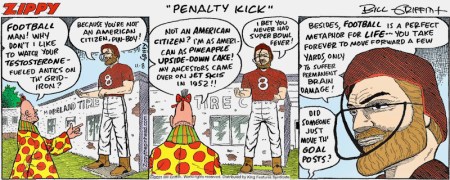(about bodies, mostly men’s, and the exposure of parts of those bodies, either by complete absence of an item of clothing, or by the absence of part of such an item; there will be plenty of male buttocks on view, and there will be discussion of men’s bodies, sometimes in street language — so not to everyone’s taste)
About items of clothing or parts of such items that are missing, lacking, absent. (I’ll explain the adjective abessive in a moment; it does some of the work of the English derivational suffix –less or the preposition without, but is of wider applicability.) Two topics in this area are standing preoccupations of this blog: (re: absent items of clothing) male shirtlessness; and (re: absent parts of items of clothing) the assless / bottomless / backless nature of jockstraps.
The actual entry point to this posting came on Facebook on 5/9/19, when John Dorrance asked about the first use of assless chaps and Season Devereux responded ,”Aren’t all chaps assless though?” To which I replied:
Yes indeed. The assless in assless chaps is an appositive, rather than restrictive, modifier — used to remind the hearer that chaps do in fact lack an ass, or to emphasize this fact in context — cf. appositive ‘chaps, which are assless’ vs. restrictive ‘chaps that are assless’, which is pleonastic.
It will take a little while to work up to chaps as abessive clothing: in this case, an item of clothing that lacks one of its parts (they’re assless) — in fact lacks two, since they’re also crotchless (chaps are essentially outerwear leggings of leather, held up by a belt).
Exploring abessive clothing quickly can take us far afield, and I’m not sure at this point how far I’m willing to go, so I’ll just dig in and see what happens. Come walk with me.
(more…)








